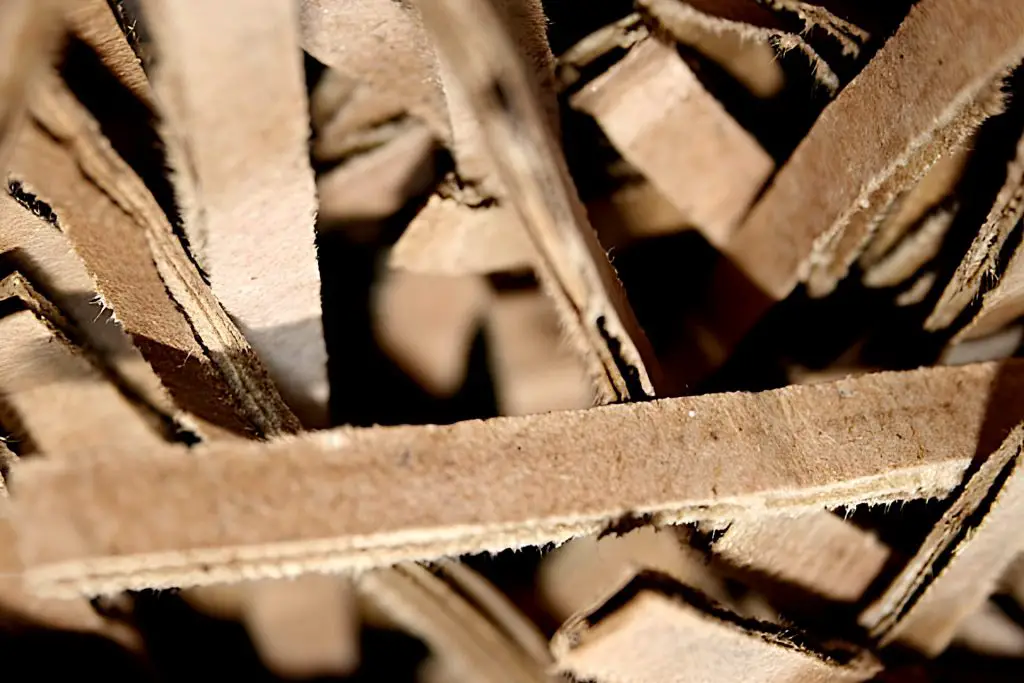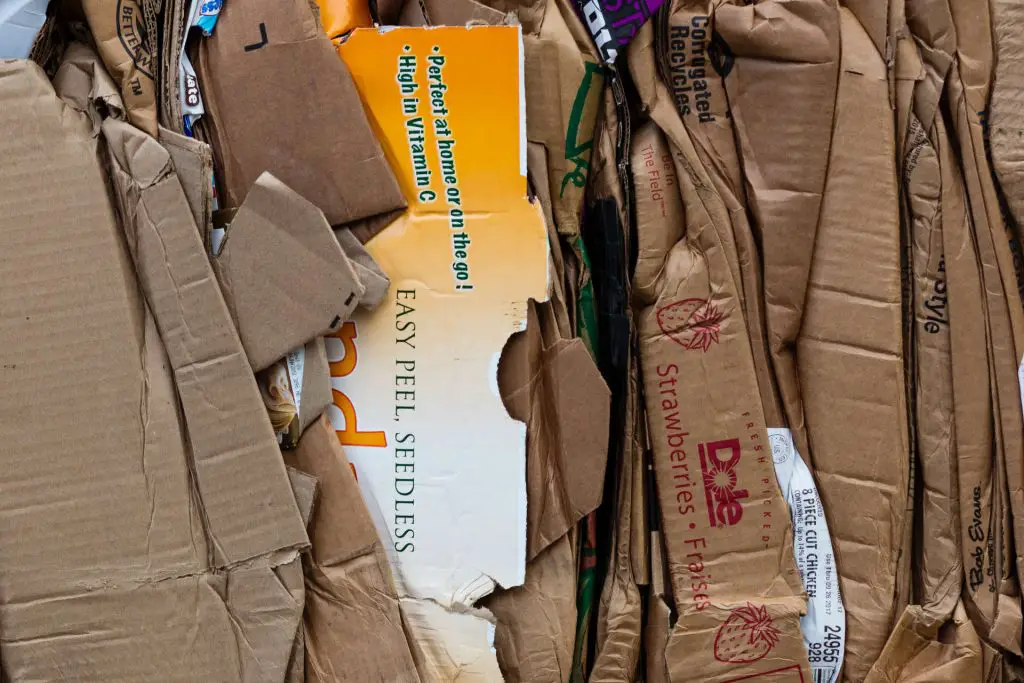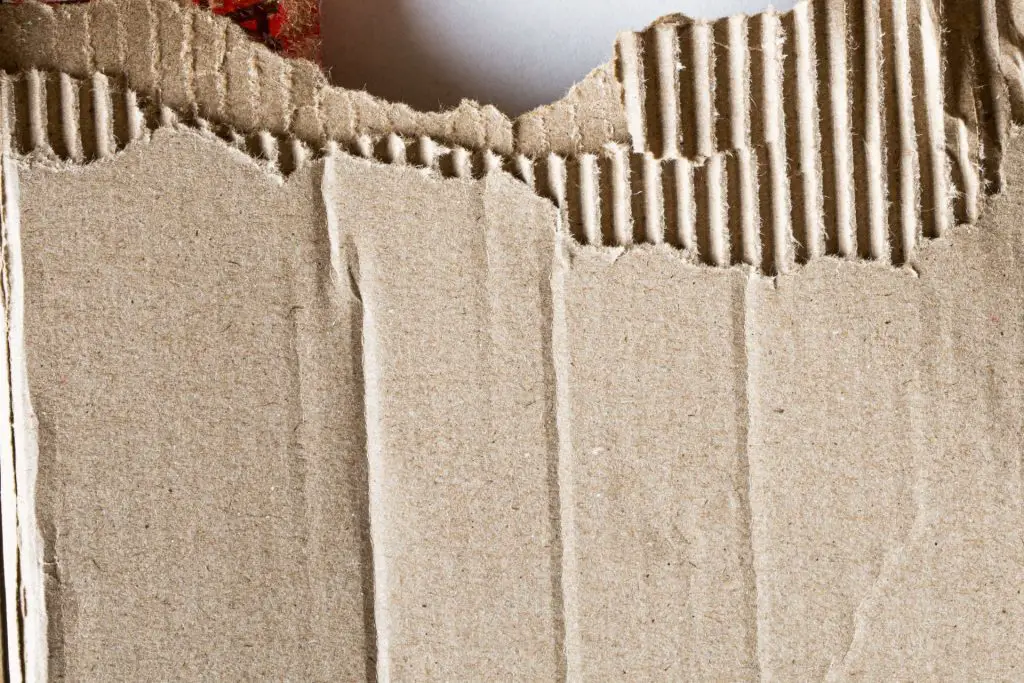Composting Cardboard: Turning Cardboard Boxes Into Black Gold
Each week it is likely that a multitude of different types of cardboard pass through your hands. Be it amazon boxes, product packaging to the cardboard tube from the inside of a toilet roll. Cardboard is everywhere, and likely to be part of anything you buy, eat or unpack!
Most people tend to recycle their waste cardboard which is a noble thing to do, but a huge 26% of it is just tossed away with the United States Environmental Agency reporting that over 17.25 million tons are put into landfills each year, making up 12% of everything thrown into Landfills.[1]
It doesn’t have to be this way because cardboard is actually a fantastic organic material that can be used in various ways in the garden, one of the most valuable being turned into compost. However, there are certain cardboards that you shouldn’t compost and we will look at these exceptions and explain why.
Can You Compost Cardboard

Cardboard is an excellent organic material that can be used to make compost. This is not only an environmentally sound way of using cardboard but is a way to reduce pressure on landfills and provide you with nutrient-rich organic compost that will help your plants thrive.
The fact that cardboard is made up of cellulose fibers[2], in fact, makes it an ideal composting material. Cardboard, being a brown organic material, means it contains a high ratio of carbon to nitrogen (around 350:1 C/N), with carbon being an important component of the soil ecosystem, helping plants grow and absorb nutrients.
Much as cardboard is a fantastic organic material, there are some cardboards that are not ideal for composting and others, particularly packaging with a plastic coating, that shouldn’t be composted unless the packaging says it is home compostable.
How to Compost Cardboard

Composting cardboard is a relatively simple process. Being made up of cellulose fibers, cardboard, similar to wood chip, will decompose gradually over time if just left outside. The problem is, that being a carbon-rich material this will take a considerable time, possibly up to 18 months or longer.
However, employing standard composting methods, such as either hot composting or cold composting, will reduce this time from anything from four to five weeks to six months depending on the method used.
Irrespective of the method the preparation of the organic materials that you will use to generate your compost is relatively similar.
Shredding the Cardboard
Tear or shred the cardboard into small pieces. The reason for doing this is that the smaller the pieces the more surface area of the original piece of cardboard is exposed to the microbes that are at the heart of the decomposition process. This speeds up the breakdown of the cardboard turning it into ready-to-use finished compost more quickly.
The thought of shredding cardboard ready for your compost pile can, at first thought, appear daunting. However, in reality, with a couple of common household devices such as a simple paper shredder and a box cutter, it can be done quickly and efficiently.
Create Your Compost Pile
Building your material pile. Composting works through the chemical reaction between carbon-rich organic materials, such as cardboard, leaves, and woodchips (browns), and nitrogen-rich materials, such as food scraps, peel, and grass clippings (greens).
You can read more about the science behind the process here, but by mixing a ratio between brown and green materials of 25:1, for hot composting and 30:1, for cold composting. Getting the ratios right is not as difficult as it seems, and particular for cold composting not too critical.
So, to build your pile you will add layers of brown materials like your cardboard and other carbon-rich materials in layers with your green materials. The bottom layer should be cardboard.
For example, a typical material pile would look like this:
- you put a layer of shredded cardboard down,
- then on top a layer of grass clippings,
- then another layer of cardboard or leaves,
- followed by a layer of vegetable and fruit peelings.
It is done this way to ensure a good mix between materials and that air can circulate (oxygen being important to the chemical process).
Finally, make sure the material pile is slightly damp because, as with oxygen, the decomposition process requires moisture.
Choose Your Composting Method
At this point which method you have chosen will determine how long it will take to get finished compost
Cold Composting
If you are cold composting and are looking to get compost ready in three to six months then you at this point just need to keep the pile slightly moist and turn it every seven to ten days. Gradually, you will notice that the pile turns black and become hotter, which is part of the chemical reaction. Over the next three to six months the pile will turn into a thick crumbly pile of black finished compost ready to use.
Hot Composting

Hot composting is similar but requires a lot more attention than cold composting, but the pay off being finished compost in four to six weeks.
The key difference is the need to raise the temperature of the pile to an optimum range of between130-150 degrees Fahrenheit. This is done by increasing the amount of air in the pile, which is already experiencing a faster reaction because of the higher nitrogen content (more green materials). Increasing the air is literally a matter of turning the pile more often, from initial every day to every two to three days after that.
If the pile can get to and remain in this temperature range then it means the decomposition process has rapidly accelerated, producing a finished compost in the reduced timeframe.
Clearly, monitoring the internal temperature of the compost heap is crucial. There are numerous compost thermometers that you might purchase that would accomplish this, but if you are brave, you can plunge your hand into the center of the pile and gauge the temperature that way.
Finished Compost from Cardboard
It might seem daunting and complex but actually, it genuinely isn’t. Composting is a very forgiving process. The worst that is likely to go wrong is that it just doesn’t decompose as fast as you would like or that it smells. Either of these issues is easily rectified.
Once you have the finished compost you can use the compost to fertilize plants or spread it directly onto your garden or plant it in pots. You can even sell the compost to other gardeners as home produced compost is considered far superior to shop-bought compost
Troubleshooting
The decomposition process seems to have stalled
If you feel that after a couple of months that decomposition is not happening fast enough, it is probably because you have either too much brown material in ration to green material in the pile, or that not enough air is getting into the pile. This can be rectified by turning the pile more often and, or adding in a little more green materials.
The compost pile has begun to smell
If your composting pile has begun to smell this is usually because you have too much nitrogen (green material) in the pile and it is giving off ammonia. This is not really a great problem and can be redressed by adding more cardboard or other brown material to compensate.
There are animals pulling at the pile
The main cause of animals being attracted is because you have used meat or dairy food scraps. These green materials are actually high in nitrogen and are good for composting. However, to avoid attracting vermin you should only use them if you have an enclosed compost bin or can protect your pile in some way. Otherwise, it is not advisable to use these food scraps for composting.
Can You Compost Colored or Printed Cardboard
Beyond the plain brown vanilla boxes, that are common in exterior packaging, there is a multitude of other different types of cardboard packaging. Most of which can be safely composted but there are a few exceptions that need to be considered.
Compostable Cardboard Packaging
A lot of product packaging is made from paperboard, thin cardboard. These are usually printed with images and words. Sometimes the cardboard can be just a block color. The concern many have is with the ink used to print these boxes.
Composting Printed Cardboard

Many inks used on today’s packaging are biodegradable or water-based. The majority of inks are made from vegetable dyes and are thus fine for composting.
Indeed, when it comes to foodstuffs, inks need to be low-migration inks so that no transfer can be made through the box or plastic inner pouch. These inks are thus not toxic and eco-friendly and won’t impact the compost.
Some packaging though still uses what is known as colored inks to print. The issue with these colored inks is that they contain heavy metals and these metals don’t decompose in the composting process, leaving traces in the soil, that can then be reabsorbed into the plants.
Having said that it also needs to be remembered that your soil already contains quantities of heavy metals. Composting cardboard that contains colored ink is unlikely to change the overall chemical makeup of your soil, unless you are composting huge quantities of it, which is improbable.
In that, you will likely be combining it with various other types of cardboard, the overall effect on the soil will be insignificant.
Does the Glue in Cardboard Affect Composting?
Some people often raise a concern about the glues that are utilized in the production of cardboard boxes. Glue is used in two different situations. One glue is used in the construction of the sheeted cardboard, the other type of glue is in the construction of the box itself.
The glue used to make the cardboard sheets are almost entirely starch-based, being derived from natural carbohydrates found in plants such as maize, wheat, potatoes, and rice among others. Being an organic material they decompose quickly with the cardboard and can be readily included in the composting process.
The boxes are also constructed using glue, this glue, however, is different. In the past, it was made from animal products but, with the upsurge in vegan consciousness, it is not always apparent which adhesive is used. The important point though is that the quantity of adhesive used in constructing the boxes is negligible and should not impact your compost.
The reality is that presence of glue on cardboard is not a significant issue and should not prevent you from composting cardboard boxes. Indeed, many millions of people do so without any issue.
Chemically Treated Cardboard
Another area of concern is chemically treated cardboard. Some cardboard is treated with waxes, fire retardant coating and sometimes anti-static compounds.
In terms of food cardboard packaging, there are strict regulations[3] and boxes cannot be constructed from any material that can cause any toxic transference. These boxes are entirely safe to compost.
Indeed it is unlikely that any chemically treated box will have any real impact as chemical concentrations are minimal on your compost, as the microbes in the decomposition process cause even these to be broken down
Is It Better to Recycle or Compost Cardboard
This is a subjective question. In truth, you are likely to do both. The more important point is that the cardboard isn’t disposed of in the general rubbish to end up in a landfill.
Cardboard is a versatile and useful material. It can be easily recycled in terms of reusing boxes or broken down to create new boxes, paper products or cardboard mulch.
The best policy is to keep as much cardboard as necessary for your composting needs. If you have way too much then you can recycle this. Although, as we have discussed, you can compost most cardboard, if you have too much, you should preference exterior brown vanilla boxes. These are the most productive in terms of composting and you can recycle thinner cardboard.
How Much Cardboard Do You Use in Compost

A common question is how much cardboard can you put in a compost pile. The answer depends very much on the size of your compost pile. The factor that dictates the amount of cardboard is the carbon-nitrogen ratio that you are using. With hot composting, this would be 25:1 (C:N) and cold composting 30-35:1 (C:N). You can add the amount of cardboard to your compost pile that keeps it within these ratio bounds.
In truth it is good practice to use a variety of brown materials such as leaves and wood chips in your compost, although cardboard is a great way of bulking it out.
Composting can be a continual process. Once your pile has become finished compost you can start again. You will be surprised how much you actually get through. It is, therefore, always useful to keep as much cardboard as you can for future composting.
Summary: Composting Cardboard
It should be clear that cardboard is a fantastic organic material that is great for composting. It is true that some cardboards are more suited than others but you can pretty much compost any type of cardboard, save those with plastic coatings. Even some of these though can be composted if marked Home Compostable.
In reality, if you are composting cardboard it is likely that you will have a variety of different types of cardboard on hand that you can compost. It is still good practice to mix your brown organic materials to produce a more nutrient-rich finished compost that will help your plants grow and thrive.
Commonly Asked Questions
Is Corrugated Cardboard Compostable?
Yes, corrugated cardboard makes an excellent composting material. Indeed, most exterior cardboard packaging, like amazon boxes, is constructed from it, so it should be a readily available source for your brown composting materials.
Can You Put Cardboard in a Compost Bin?
Yes, you can put cardboard in a compost bin. The chemical process triggered when composting is the same as whichever composting process you use. To expedite the decomposition process you should cut the cardboard or shred the cardboard into small pieces.
Are Cardboard Food Boxes Compostable?
Yes, generally cardboard food boxes are fine to compost. Any printing on these boxes uses low-migration inks, which are non-toxic and eco-friendly, in case of transference through the cardboard. Composting these will have no adverse impact on the compost.
The only food boxes to be concerned about are those with a plastic coating (shiny finish). You should avoid composting these unless they are marked “Home Compostable”.
How Long for Cardboard to Compost?
If just left outside cardboard can take 18 months or more to decompose. If shredded and used in a compost pile it can take anywhere from four weeks and six months to become finished compost, depending on the composting process employed.
Notes:
[1] United States Environmental Protection Agency: National Overview: Facts and Figures on Materials, Wastes and Recycling
[2] “Cellulose is an organic compound that is obtained from wood pulp. It is principally used to produce paper and paperboard. Microcellulose (also named as microcrystalline cellulose) is a type of cellulose that has micro-scaled fibers.” Alexander Chernyaev, Tampere University: The Use of Microcellulose in Papermaking
[3] U.S. Food and Drug Administration: Packaging & Food Contact Substances (FCS)
